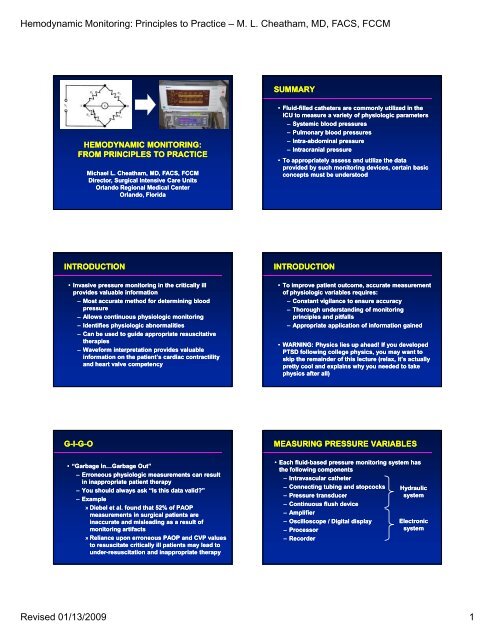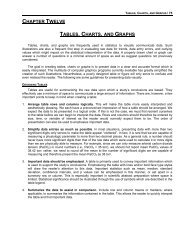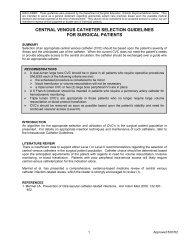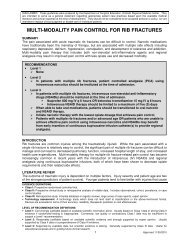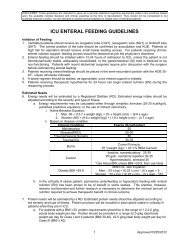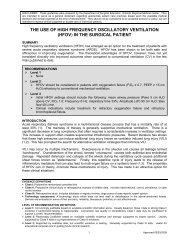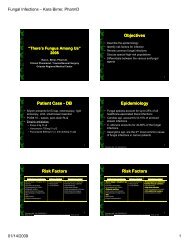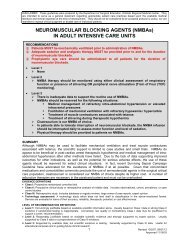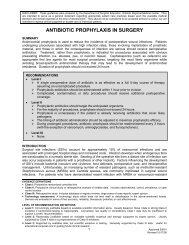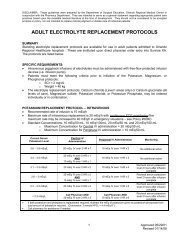Hemodynamic Monitoring: Principles to Practice â M. L. Cheatham ...
Hemodynamic Monitoring: Principles to Practice â M. L. Cheatham ...
Hemodynamic Monitoring: Principles to Practice â M. L. Cheatham ...
Create successful ePaper yourself
Turn your PDF publications into a flip-book with our unique Google optimized e-Paper software.
<strong>Hemodynamic</strong> <strong>Moni<strong>to</strong>ring</strong>: <strong>Principles</strong> <strong>to</strong> <strong>Practice</strong> – M. L. <strong>Cheatham</strong>, MD, FACS, FCCMSUMMARYHEMODYNAMIC MONITORING:FROM PRINCIPLES TO PRACTICEMichael L. <strong>Cheatham</strong>, MD, FACS, FCCMDirec<strong>to</strong>r, Surgical Intensive Care UnitsOrlando Regional Medical CenterOrlando, Florida• Fluid-filled catheters are commonly utilized in theICU <strong>to</strong> measure a variety of physiologic parameters– Systemic blood pressures– Pulmonary blood pressures– Intra-abdominal abdominal pressure– Intracranial pressure• To appropriately assess and utilize the dataprovided by such moni<strong>to</strong>ring devices, certain basicconcepts must be unders<strong>to</strong>odINTRODUCTION• Invasive pressure moni<strong>to</strong>ring in the critically illprovides valuable information– Most accurate method for determining bloodpressure– Allows continuous physiologic moni<strong>to</strong>ring– Identifies physiologic abnormalities– Can be used <strong>to</strong> guide appropriate resuscitativetherapies– Waveform interpretation provides valuableinformation on the patient’s cardiac contractilityand heart valve competencyINTRODUCTION• To improve patient outcome, accurate measuremen<strong>to</strong>f physiologic variables requires:– Constant vigilance <strong>to</strong> ensure accuracy– Thorough understanding of moni<strong>to</strong>ringprinciples p and pitfalls– Appropriate application of information gained• WARNING: Physics lies up ahead! If you developedPTSD following college physics, you may want <strong>to</strong>skip the remainder of this lecture (relax, it’s actuallypretty cool and explains why you needed <strong>to</strong> takephysics after all)G-I-G-O• “Garbage In…Garbage Out”– Erroneous physiologic measurements can resultin inappropriate patient therapy– You should always ask “Is this data valid?”– Example» Diebel et al. found that 52% of PAOPmeasurements in surgical patients areinaccurate and misleading as a result ofmoni<strong>to</strong>ring artifacts» Reliance upon erroneous PAOP and CVP values<strong>to</strong> resuscitate critically ill patients may lead <strong>to</strong>under-resuscitation resuscitation and inappropriate therapyMEASURING PRESSURE VARIABLES• Each fluid-based pressure moni<strong>to</strong>ring system hasthe following components– Intravascular catheter– Connecting tubing and s<strong>to</strong>pcocksHydraulic– Pressure transducersystem– Continuous flush device– Amplifier– Oscilloscope / Digital displayElectronic– Processorsystem– RecorderRevised 01/13/20091
<strong>Hemodynamic</strong> <strong>Moni<strong>to</strong>ring</strong>: <strong>Principles</strong> <strong>to</strong> <strong>Practice</strong> – M. L. <strong>Cheatham</strong>, MD, FACS, FCCMMEASURING PRESSURE VARIABLES• The hydraulic system is much more subject <strong>to</strong>potential errors and artifacts than is the electronicsystem– Learning <strong>to</strong> troubleshoot the hydraulic portion of ainvasive pressure moni<strong>to</strong>ring system is essential» Confirms the validity of the data» Helps avoid inappropriate therapeuticinterventions based upon erroneous dataHYDRAULIC SYSTEM COMPONENTS• Intravascular catheter– Tubing <strong>to</strong> access the desired blood vessel orcompartment– Detects the pressure waves generated by cardiaccontraction• Connecting tubing and s<strong>to</strong>pcocks– Transmits pressure wave from patient <strong>to</strong>measuring device– Allows control of blood vessel <strong>to</strong> avoidhemorrhage, introduction of air, etc…PRESSURE TRANSDUCER• Converts the mechanical impulse of a pressure wavein<strong>to</strong> an electrical signal through movement of a “straingauge”– Modern transducers utilize a displaceable siliconsensing diaphragm and a “Wheats<strong>to</strong>ne Bridge”Transducer DomeSensing DiaphragmWHEATSTONE BRIDGE• An electrical circuit forcomparison of resistances• Consists of a power source andfour resis<strong>to</strong>rs, three of whichhave a known resistance• To determine the unknownresistance, the resistance of theother three are balanced until thecurrent passing through bothsides of the parallel “bridge”decreases <strong>to</strong> zeroPressure TubingPressure WaveWHEATSTONE BRIDGE• The Wheats<strong>to</strong>ne Bridge is used <strong>to</strong> measure theresistance change in a strain gauge– The resistance change is proportional <strong>to</strong> thechanging physiologic variable (i.e. pressure) ormechanical strain applied <strong>to</strong> the transducer– “Zeroing” a transducer is simply determining thevalue of the unknown resistance at rest» “Balancing the bridge”– As the physiologic variable changes, theresistance varies proportionally, a current isinduced across the bridge, and the voltmetervalue is converted <strong>to</strong> a pressure measurementHYDRAULIC SYSTEM COMPONENTS• Continuous flush device– Flushes the tubing with fluidat a rate of 1-3 mL/hr andhelps prevent blood fromclotting off the catheter– The “fast flush” featureincreases the flow <strong>to</strong> 30mL/min and can be used <strong>to</strong>test the system’s complianceRevised 01/13/20092
<strong>Hemodynamic</strong> <strong>Moni<strong>to</strong>ring</strong>: <strong>Principles</strong> <strong>to</strong> <strong>Practice</strong> – M. L. <strong>Cheatham</strong>, MD, FACS, FCCMELECTRONIC SYSTEM COMPONENTSMEASURING PRESSURE VARIABLES• Amplifier– Increases the low voltage signal from the pressuretransducer <strong>to</strong> a signal that can be displayed– Most include electronic filters <strong>to</strong> remove unwantedphysiologic “noise”SIGNALPRESSURETRANSDUCERAMPLIFIER & SIGNALCONDITIONINGANALOG TO DIGITALCONVERTER• Oscilloscope / Digital display– Used <strong>to</strong> display waveforms and numerical dataSTRIP RECORDERBEDSIDE MONITORMICROPROCESSOR• Processor– Used <strong>to</strong> calculate various hemodynamic parameters• Recorder– A printer, strip chart recorder, or other deviceTYPICAL RADIAL ARTERY PRESSUREMONITORING SYSTEMCLINICAL CORRELATION• What do these measurements mean clinically?– Sys<strong>to</strong>lic pressure» The pressure exerted on the artery walls due <strong>to</strong>left ventricular contraction (i.e., contractility)– Dias<strong>to</strong>lic pressure» The pressure exerted during left ventricularrelaxation (i.e., vascular resistance)– Pulse pressure» The difference between peak sys<strong>to</strong>lic anddias<strong>to</strong>lic pressures (i.e., perfusion)CLINICAL CORRELATION• What do these measurements mean clinically?– Dicrotic notch pressure» The pressure thatreflects aortic valveclosure– Heart rate» The frequency ofcontraction measuredin beats per minute– Ejection time» The time of leftventricular ejectionPHYSICS OF PRESSURE MONITORING• The typical catheter-transducer transducer system in the ICU isconsidered <strong>to</strong> be a “second-order order dynamic system”– The pressure waveform dampens over time– Determined by two fac<strong>to</strong>rs» “Natural frequency”– The number of oscillations per unit time tha<strong>to</strong>ccurs without any damping» “Damping coefficient”– The time taken <strong>to</strong> dampen the waveformRevised 01/13/20093
<strong>Hemodynamic</strong> <strong>Moni<strong>to</strong>ring</strong>: <strong>Principles</strong> <strong>to</strong> <strong>Practice</strong> – M. L. <strong>Cheatham</strong>, MD, FACS, FCCMPHYSICS OF PRESSURE MONITORING• For example, when dropped on<strong>to</strong> a hard floor, a ballbounces several times before coming <strong>to</strong> rest– With each successive bounce, it does not rise ashigh as on the previous bounce– Each bounce has a characteristic frequency (thenumber of oscillations per unit time) anddamping coefficient (time that it takes the ball <strong>to</strong>come <strong>to</strong> a rest)Damping CoefficientFrequencyPHYSICS OF PRESSURE MONITORING• However, if the same ball is dropped on<strong>to</strong> soft earth,the ball will not bounce as high, resulting in adecreased frequency, and will come <strong>to</strong> rest sooner,reflecting an increased damping coefficient– This can be expressed mathematically BUT youdon’t need <strong>to</strong> know how <strong>to</strong> calculate it ☺P2=P12f2− Fn1f+ 2 jξF n+ 1P 1 , P 2 are output and input signals of the pressure transducerrespectively, f is an arbitrary frequency, F n is the natural frequency,ξ is the damping coefficient, and j is the complex numberPHYSICS OF PRESSURE MONITORING• The accuracy of a second-orderorder system is subject <strong>to</strong>three mechanical fac<strong>to</strong>rs1. Compliance• The stiffness of the fluid-filledfilled system (tubing)2. Fluid inertia• The pressure required <strong>to</strong> move fluid (blood)through the system3. Fluid resistance• The viscosity of the fluid moving through thesystem (resistance due <strong>to</strong> friction)DETERMINING THE NATURAL FREQUENCYAND DAMPING COEFFICIENT• This can also be expressed mathematically BUTyou don’t need <strong>to</strong> know how <strong>to</strong> calculate it ☺F n1=RCξ =2πIC 2 IF n is the natural frequency, ξ is the damping coefficient,C = compliance, I = inertia, and R = resistancePHYSICS OF PRESSURE MONITORING• The complex pressure wave generated with eachbeat of the heart is not unlike the bouncing ball– A pressure waveform is propagated at a givenfrequency (beats per minute)– The vascular resistance acts as the dampingcoefficient anddiminishesthewaveform’senergy and magnitude over time• The resulting arterial sine wave, occurring at therateof thepatient’spulse, iscalledthefirstharmonic or fundamentalPHYSICS OF PRESSURE MONITORING• If the waveform is reflected off atransduceror otherobstruction within the catheter-tubingtubing system, awave reflection or “harmonic” is generated– These harmonic waveforms are additive and canintroduce error in<strong>to</strong> pressure measurementsRevised 01/13/20094
<strong>Hemodynamic</strong> <strong>Moni<strong>to</strong>ring</strong>: <strong>Principles</strong> <strong>to</strong> <strong>Practice</strong> – M. L. <strong>Cheatham</strong>, MD, FACS, FCCMPHYSICS OF PRESSURE MONITORING• Without some degree of damping within a system,pressure waves reverberate within the catheter andtubing leading <strong>to</strong> the formation of harmonics andoverestimation of true blood pressure– An “underdamped”” system• With <strong>to</strong>o much damping, the frictional forces impedethe arterial waveform such that it loses energyleading <strong>to</strong> underestimation of blood pressure– An “overdamped”” systemUNDERDAMPED WAVEFORM• Note the characteristicnarrow, peaked waveform– Overestimates sys<strong>to</strong>licand underestimatesdias<strong>to</strong>lic blood pressure– Mean arterial pressureremains unchanged!• Causes– Long stiff tubing,increased vascularresistanceOVERDAMPED WAVEFORM• Note the characteristic widenedand slurred waveform– Underestimates sys<strong>to</strong>licand overestimates dias<strong>to</strong>licblood pressure– Mean arterial pressureremains unchanged!• Causes– Air bubbles, complianttubing, catheter kinks,blood clots / fibrin,s<strong>to</strong>pcocks, no fluid or lowflush bag pressureOPTIMAL DAMPING• Some damping is essential<strong>to</strong> avoid harmonics– The “optimal” amount ofdamping is crucial <strong>to</strong>accurate measuremen<strong>to</strong>f physiologic pressures• A catheter-transducertransducersystem accurately measurespressure only if its naturalfrequency and dampingcoefficient are appropriateFREQUENCY RESPONSE• A pressure moni<strong>to</strong>ring system should be able <strong>to</strong>detect changes quickly (known as the “frequencyresponse”)• Damping will tend <strong>to</strong> decrease frequency response– Important if changes are occurring rapidly suchas with tachycardia or a hyperdynamic heart• The ideal moni<strong>to</strong>ring system has ahigh“natural” or“undamped” frequency– The frequency that would occur in the absence ofany frictional forces or damping– Allows accurate measurement of fast heart ratesDYNAMIC RESPONSE ARTIFACTS• Underdamped and overdamped waveforms areencountered in the ICU on a daily basis– Look for them at the bedside!• The ability <strong>to</strong> recognize when these potentialsources of error or “dynamic response artifacts” arepresent is essential <strong>to</strong> the…– Appropriate use of hemodynamic measurements– Prevention of inappropriate therapy based uponerroneous dataRevised 01/13/20095
<strong>Hemodynamic</strong> <strong>Moni<strong>to</strong>ring</strong>: <strong>Principles</strong> <strong>to</strong> <strong>Practice</strong> – M. L. <strong>Cheatham</strong>, MD, FACS, FCCMDYNAMIC RESPONSE ARTIFACTS• Because dynamic response artifacts are commonlyencountered during patient moni<strong>to</strong>ring, titration ofmedications should ALWAYS be based upon meanarterial pressure (MAP)– This variable is less subject <strong>to</strong> measurementerror due <strong>to</strong> under- or overdamping• Sys<strong>to</strong>lic and dias<strong>to</strong>lic blood pressure should NOTbe used <strong>to</strong> titrate therapy!TROUBLESHOOTING• OK, now let’s get practical…• The simpler the pressure moni<strong>to</strong>ring system, thehigher its fidelity, the less it is subject <strong>to</strong> dynamicresponse artifacts, and the less likely it will be <strong>to</strong>produce erroneous data• There are a number of steps that should beundertaken whenever setting up or troubleshootinga catheter-transducer transducer systemTROUBLESHOOTING• Remove multiple s<strong>to</strong>pcocks, multiple injection ports,and long lengths of tubing whenever possible– The optimal length of pressure tubing is 4 feet» Longer lengths of tubing promote harmonicamplification and underdamping– Ensure that arterial pressure tubing is being used» Overly compliant tubing leads <strong>to</strong> overdamping– Avoid large diameter tubing» Prevents achievement of optimal dampingTROUBLESHOOTING• Remove all air bubbles from the system– Perhaps the single most important step inoptimizing dynamic response» Air acts as a “shock absorber”– Bubbles as small as 1 mm in diameter cancause substantial waveform dis<strong>to</strong>rtion» Leads <strong>to</strong> overdamping and flattened waveforms– Ensure that all connections are tight andperiodically flush all tubing and s<strong>to</strong>pcocks <strong>to</strong>remove air bubblesTROUBLESHOOTING• Whenever you are evaluating a patient’s changinghemodynamics– Check all transducers, s<strong>to</strong>pcocks, tubing, andinjection ports for air– Gently tap the tubing and s<strong>to</strong>pcocks as thecontinuous flush valve is opened <strong>to</strong> dislodge anybubbles» This will usually clear the system and res<strong>to</strong>remeasurement accuracy» Flushing a few small bubbles through thecatheter is OK; if more air is present, aspirate itfrom the tubingTROUBLESHOOTING• Zero the transducer– The accuracy of invasive pressure measurementsis dependent upon a proper reference point» The “midaxillary line” or “phlebostatic axis” iscommonly utilized– Each transducer should be zeroed at least onceeach day and whenever data is considered suspectRevised 01/13/20096
<strong>Hemodynamic</strong> <strong>Moni<strong>to</strong>ring</strong>: <strong>Principles</strong> <strong>to</strong> <strong>Practice</strong> – M. L. <strong>Cheatham</strong>, MD, FACS, FCCMTROUBLESHOOTING– Transducers may be attached <strong>to</strong> the patient or <strong>to</strong> apole at the head of the bed– Changes in bed positioning generally require re-zeroing the pressure transducer» If the transducer is below the phlebostatic axis,the resulting arterial pressure will beerroneously high» If the transducer is above the phlebostatic axis,the resulting arterial pressure will beerroneously lowTROUBLESHOOTING• The “fast-flush” flush” or “square wave” test– Performed by opening the continuous flush valvefor several seconds creating a square wave» A system with appropriate dynamic responsecharacteristics will return <strong>to</strong> the baselinewaveform within one <strong>to</strong> two oscillations» If dynamic response characteristics areinadequate, troubleshoot the system untilacceptable dynamic response is achievedCONCLUSIONS• Direct pressure moni<strong>to</strong>ring is essential fordetermining immediate changes in blood pressure• The arterial waveforms provide valuable diagnosticand treatment information• If not accurate, the erroneous data within thesewaveforms can potentially lead <strong>to</strong> detrimentaltreatment• Look at both the bedside moni<strong>to</strong>r waveforms ANDthe numerical data– The waveforms can tell you a great dealCONCLUSIONS• All hemodynamic data should be considerederroneous until you are satisfied that the dynamicresponse characteristics of the moni<strong>to</strong>ring systemare appropriate• Learn <strong>to</strong> troubleshoot each moni<strong>to</strong>ring system sothat you can ensure the accuracy of your patient’sdata• Physics is important after all ☺Revised 01/13/20097


